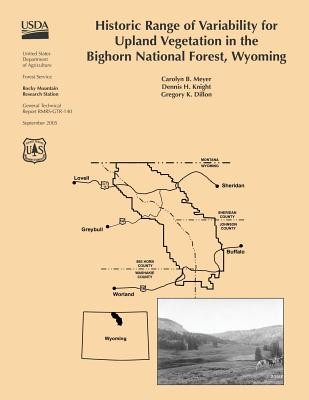
- We will send in 10–14 business days.
- Author: United States Department of Agriculture
- Publisher: CreateSpace Independent Publishing Platform
- ISBN-10: 1511476079
- ISBN-13: 9781511476072
- Format: 21.6 x 28 x 0.6 cm, softcover
- Language: English
- SAVE -10% with code: EXTRA
Historic Range of Variability for Upland Vegetation in the Bighorn National Forest, Wyoming (e-book) (used book) | bookbook.eu
Reviews
Description
An approach for synthesizing the results of ecological research pertinent to land management is the analysis of the historic range of variability (HRV) for key ecosystem variables that are affected by management activities. This report provides an HRV analysis for the upland vegetation of the Bighorn National Forest in northcentral Wyoming. The variables include live tree density, dead tree (snag) density, canopy cover, abundance of coarse woody debris, species diversity, fire return intervals, the abundance of various diseases, the proportion of the landscape in different land cover types, and the degree of patchiness in the landscape. The variables were examined at the stand and landscape scales, using information available in the literature and USFS databases. High-elevation landscapes were considered separately from low-elevation landscapes. Much of the report pertains to forests dominated by lodgepole pine, subalpine fir, and Engelmann spruce at high elevations, and by ponderosa pine, aspen, and Douglas-fir at lower elevations. We defined the HRV reference period for the BNF as approximately 1600 to 1890.
EXTRA 10 % discount with code: EXTRA
The promotion ends in 18d.13:29:03
The discount code is valid when purchasing from 10 €. Discounts do not stack.
- Author: United States Department of Agriculture
- Publisher: CreateSpace Independent Publishing Platform
- ISBN-10: 1511476079
- ISBN-13: 9781511476072
- Format: 21.6 x 28 x 0.6 cm, softcover
- Language: English English
An approach for synthesizing the results of ecological research pertinent to land management is the analysis of the historic range of variability (HRV) for key ecosystem variables that are affected by management activities. This report provides an HRV analysis for the upland vegetation of the Bighorn National Forest in northcentral Wyoming. The variables include live tree density, dead tree (snag) density, canopy cover, abundance of coarse woody debris, species diversity, fire return intervals, the abundance of various diseases, the proportion of the landscape in different land cover types, and the degree of patchiness in the landscape. The variables were examined at the stand and landscape scales, using information available in the literature and USFS databases. High-elevation landscapes were considered separately from low-elevation landscapes. Much of the report pertains to forests dominated by lodgepole pine, subalpine fir, and Engelmann spruce at high elevations, and by ponderosa pine, aspen, and Douglas-fir at lower elevations. We defined the HRV reference period for the BNF as approximately 1600 to 1890.


Reviews